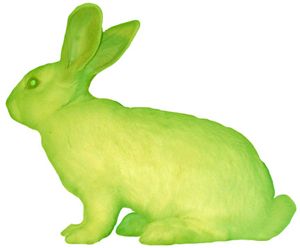Week 6: Biotechnology and Art
Many of the
technologies this week I had previously only considered for very scientific,
academic reasons. I had learned about GFP in the context of ontogenetics and
mouse neurons, and about white blood cells in the context of immunology. I had
never considered that someone might inject different genes into an organism for
art purposes, as Eduardo Kac did with his GFP Bunny, using transgenic art to
make an albino bunny glow green under ultraviolet light (Kac). This does make me
question the ethics behind transgenic art: are we, humans, at liberty to mess
with the natural order of the world? How far is too far? I think I agree with
the scientists who consider this idea interesting, but silly – with so many
things that we do not know about genetics, diseases, and the human body, it
seems that the resources used to make the green bunny could be put towards
helping people instead (Vesna).
 |
| Kac's GFP Bunny |
Kathy High’s Blood Wars, while
artistic, seems to me like an art piece that could also have interesting
implications for the medical field (About the Project). The Blood Wars involve
two different people’s white blood cells battling for dominance in a petri
dish, until the strongest cells win. It would be interesting to keep track of
the characteristics of the winning cells and see how these affect that person’s
ability to fight disease. Such information could be used to treat those with
weak immune systems.
 |
| A snapshot of High's Blood Wars in a petri dish |
Kathy High is a contributor at
SymbioticA, a biotechnological art laboratory in Australia, where many
interesting art pieces have been constructed, from Adam Zaretsky’s studies of
the effects of music and sounds on E. Coli bacteria (Zaretsky), to Oron Catts’s
Autotroph, a kinetic sculpture which explores the issues of human solutions to
human-caused climate change (Oron Catts: The Autotroph). The unique
perspectives coming from SymbioticA challenge how we typically view science and
appear to use art to make new discoveries that can help make the world a better
place. Thus, it is clear that the uniting of biotechnology and art can provide
new perspectives that could result in new, unconventional discoveries that
would not have come about without a heightened level of creativity from the
artist.
 |
| Oron Catts's Autotroph |
Works Cited
“About the
Project.” Blood Wars, Vampire Study Group,
vampirestudygroup.com/bloodwars/about/.
“The
Autotroph.” The Tissue Culture and Art Project, University of Western
Australia , lab.anhb.uwa.edu.au/tca/.
High, Kathy. “Blood
Wars in Petri Dish .” Kathy High ,
kathyhigh.com/project-blood-wars.html.
Kac, Eduardo.
“GFP BUNNY.” NATURAL HISTORY OF THE ENIGMA, 2000,
www.ekac.org/gfpbunny.html#gfpbunnyanchor.
“Oron Catts:
The Autotroph.” The SymbioticA Research Group : SymbioticA , The
University of Western Australia,
www.symbiotica.uwa.edu.au/residents/catts-adaptation.
Vesna ,
Victoria, director. 5 Bioart pt1 1280x720. YouTube, 18 Sept.
2013, youtu.be/PaThVnA1kyg.
Young, Emma.
“GFP Bunny .” New Scientist, 22 Sept. 2000, www.newscientist.com/article/dn16-mutant-bunny/.
Zaretsky, Adam.
“Documents from Adam Zaretsky's Research Affiliation with the Department of
Biology, Massachusetts Institute of Technology in the Arnold Demain Laboratory
of Microbiology and Industrial Fermentation.” BioArtLab,
emutagen.com/artbiogl.html.

Comments
Post a Comment